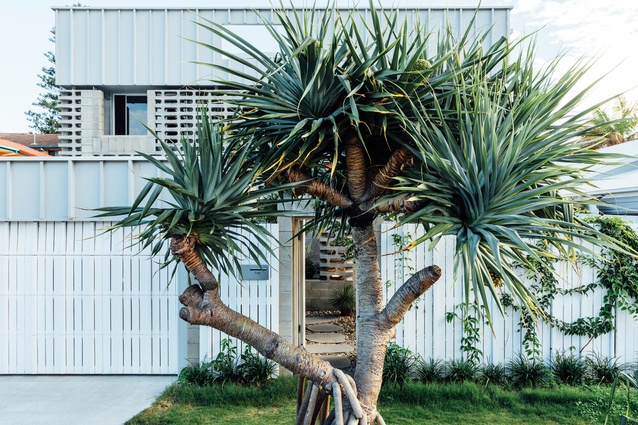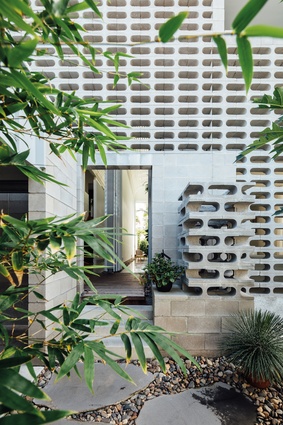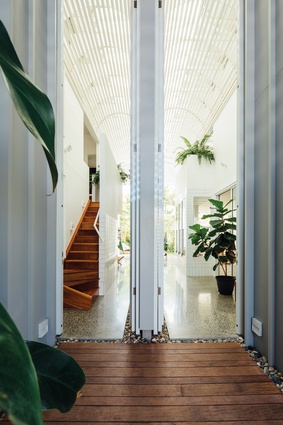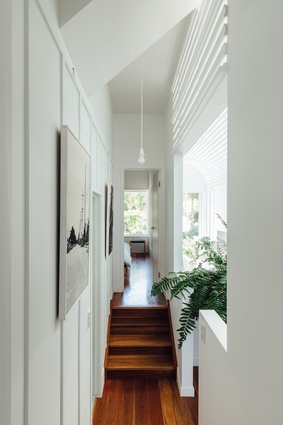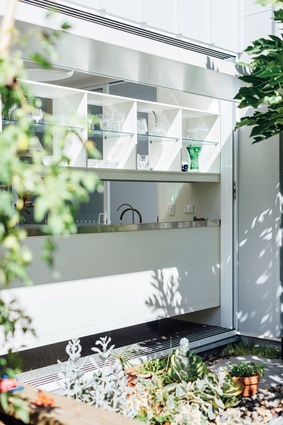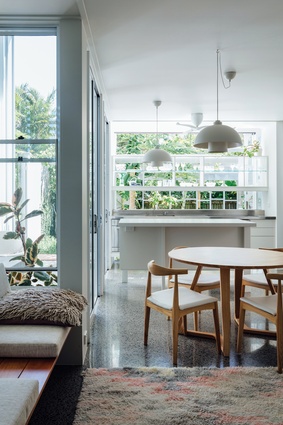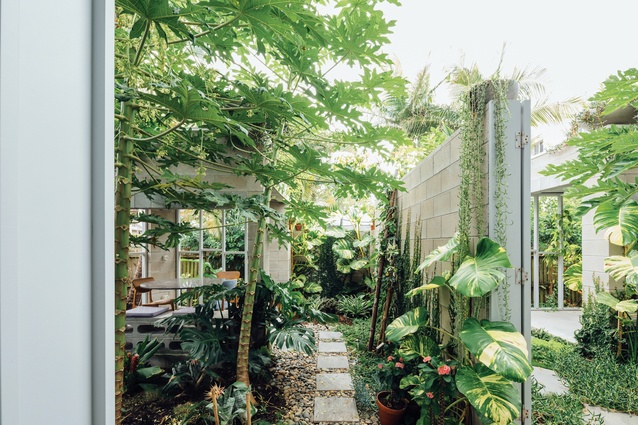Living side-by-side: Mermaid Multihouse
Twin dwellings artfully coalesce in this flexible Gold Coast home, designed by Partners Hill with Hogg and Lamb to provide a mother and son with moments of connection and retreat, agency and privacy.
Intriguingly, Mermaid Multihouse by Partners Hill with Hogg and Lamb is described by the architects as a “demonstration project,” signalling its value as a scheme with qualities and outcomes worth reproducing. In these terms, the design proposes a judiciously original and intelligible vision for the dual occupation of a suburban block.
Pooling their resources for a dual occupancy rebuild on the site of their former family home on Queensland’s Gold Coast, a multi-generational client pair (a mother and her adult son) set the path for Mermaid Multihouse, seeking a better outcome together than each could obtain singly.
The pair is indicative of the shrinking size and increasing diversity of household types in Australia. In South East Queensland, only 30 per cent of households comprise couples with children. Over his career, architect Timothy Hill, of Partners Hill, has designed many homes for clients in the other 70 percent. He recognizes that the typical detached family house is restrictive and inflexible in accommodating inevitable life transformations.
Within the conventions of the standard family house plan, running a business from home, hosting short-stay guests and accommodating long-stay occupants – including adult children or ageing parents – can become uncomfortable and often unviable. The Mermaid Multihouse seeks to explore alternatives, offering a more functionally manoeuvrable and spatially distinguished environment for multi-generational or otherwise non-traditional households.
The duplex type is reimagined with an artful ingenuity in the Mermaid Multihouse. From the exterior, the building appears as grandly singular. Timothy’s playful characterization of “post-coastal Miami Italianate” aptly summarizes the feeling of the place, with its layered allusions to local influences and distant precedents. Villa-like in its street-front presentation, the building articulates into three parts.
A piano nobile is suggested in the subtle elevation of the main living level, useful in the subtropics to get above wet ground and facilitate drainage for thriving gardens. Structural concrete H-blocks are unconventionally composed to form a defensive but breathable screen, achieving the familiar beachside breezeblock effect but with greater gravitas and better economy. And a parapet is constructed from that other hardy beachside fabric, fibre cement sheet, scribed with vertical battens to texture the planes.
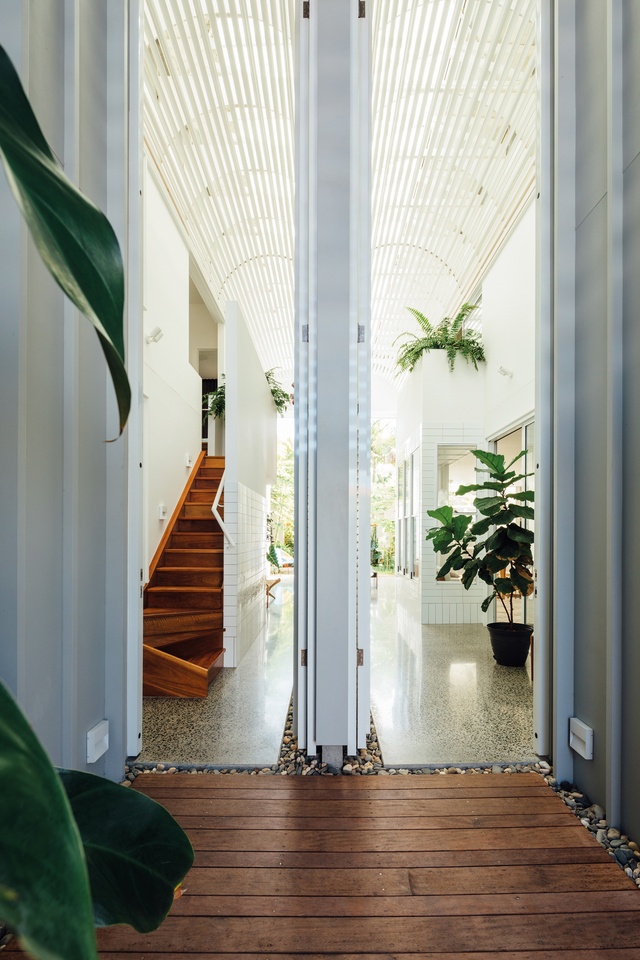
A high timber fence integrating access to the double carport bounds the block. The entry sequence begins at the gatehouse, a masonry portal crowned by a lantern made of the restyled H-blocks. Across a pebbled garden court of zoysia, succulents and subtropicals, another sentry-like block fragment, mounted on a plinth, marks the next transition through the blockwork screen to a bridging foyer of floating timber.
Once through the textural plane of the porous facade, the duplex presents an articulate but spare simplicity. A novel interpretation of the party wall divides the two dwellings into non-identical architectural twins. From the wall spring two white-battened barrel vaults, forming airy double-height arcades that temper the daylight flowing through the skylights set into the roof above. These serene spaces are permanently open to the outdoors, secured by monumental but lightweight full-height gates. Grounded by reflective polished concrete moated by pebbles, the arcades surprise and delight as they reach inwards, loftily framing views of lush gardens at the rear of the block.
The planning of each dwelling is economical, with service areas and vertical connections pocketed to support individual rooms. The arcades augment the modest two-level residences, externalizing circulation and providing opportunities for casual occupation. The arcades also create a sense of spatial grandeur and expanse from within the flat suburban block, drawing in the private landscapes and views to street and sky.
Difficult to imagine from the plans, the luxurious connective spaces were “a leap of faith” for the client but unlocked an entirely fresh conception of the duplex to harness the benign beachside environment. The tall, daylit realms create an independent address for each home and a protected microclimate onto which the rooms open, such that all enjoy daylight and fresh air on at least two sides.
The twinned sequence of outdoor and semi-outdoor spaces concludes in a pair of garden rooms, off-axis, at the northern extent of the site. Separated from the main building by a small grove of pawpaw trees, each pavilion introduces a new orientation to the whole and is a place of intimate retreat. Each is served by a north-facing kitchen that opens wide to the lush little world.
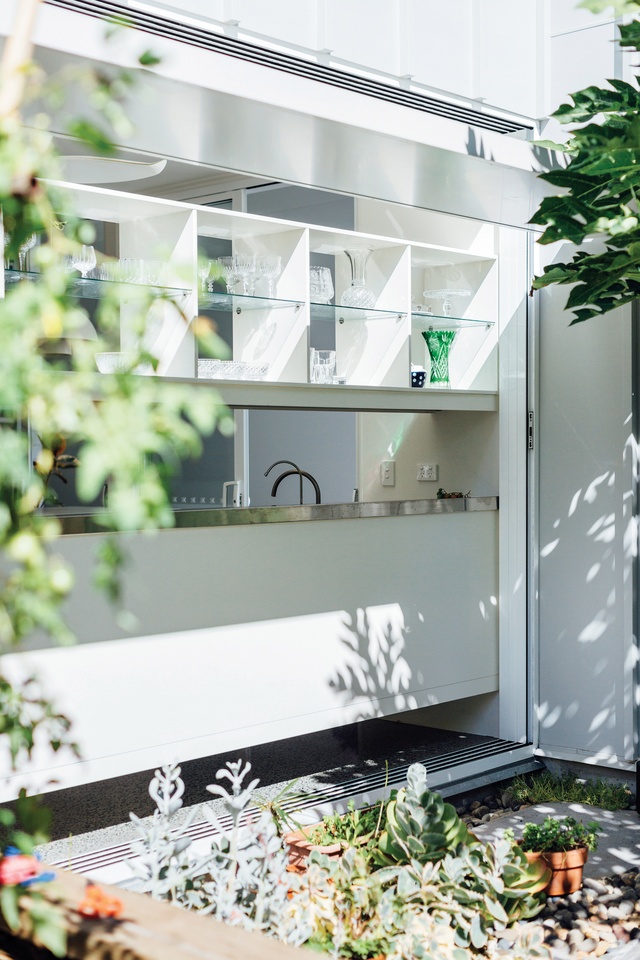
The Mermaid Multihouse offers an alternative model for achieving two distinctive and flexible homes on a modest budget. The collaboration between architect and contractor yielded an economical scheme using typical construction methods with innovative applications of off-the-shelf building components.
In this inaugural model, two related individuals happily coexist side-by-side with agency and privacy. However, the essential configuration – of gated territory, permeable but protective facade and climate-modifying arcades open to autonomous dwellings – could readily host other household types and uses, and denser occupations, gently enriching the subtropical suburbs with new options to meet contemporary needs.
This article first appeared on architectureau.com.

